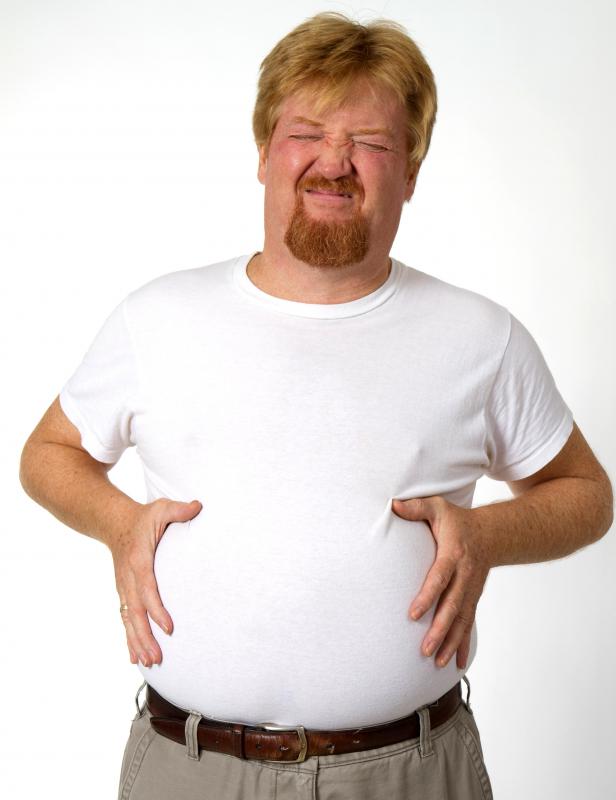At WiseGEEK, we're committed to delivering accurate, trustworthy information. Our expert-authored content is rigorously fact-checked and sourced from credible authorities. Discover how we uphold the highest standards in providing you with reliable knowledge.
What Is Gastric Distension?
Gastric distension is an uncomfortable inflation of the stomach caused by gas. This can occur when a patient is not properly ventilated during cardiopulmonary resuscitation (CPR) or medical procedures, or as a complication of procedures where gas is introduced into the abdomen. In some cases, it can be the result of overeating, seen in people with some eating disorders and conditions like Prader-Willi syndrome. These patients may lack the checks that normally curb unsafe food intake.
Classically, gastric distension can occur when someone performs CPR and air travels down the esophagus instead of the trachea, causing the stomach to fill with air. Tilting the head back can reduce the chance of this, as can paying attention to signs that air is entering the stomach and not the lungs. There are two concerns with gastric distension in this case. The patient may not be getting enough oxygen, or the stomach contents could push into the lungs and cause an infection.

Similar gastric distension can be seen when endotracheal tubes are not placed correctly and air from a mechanical ventilator or hand-held bag is pushed into the stomach. Care providers need to pull the tube back and reinsert it to protect the patient. To empty the stomach safely, patients can be placed on their sides while gentle pressure is applied to the stomach to encourage the air to vent. If the patient vomits, it will be more likely to flow out the mouth than into the lungs in this position.

Some surgeries involve pumping carbon dioxide into the abdomen to inflate it, making the contents easier for the surgeon to see. This is common with endoscopic surgery, where the care provider enters through small incisions. The contents of the abdomen can be difficult to navigate when it’s hard to see, and gas inflation pushes them apart to allow the surgeon to clearly visualize the contents. Sometimes poor placement results in gas leaks into the stomach, particularly in procedures involving the stomach, intestines, or trachea.

Another potential concern is gastric dilation, which goes beyond gastric distension. It includes a mixture of food and gas which the patient may not be able to digest. The inflated stomach presses against the diaphragm, which can make it hard to breathe. If the patient eats too much, the stomach can actually rupture, creating a life-threatening medical emergency. Normally, gastric distension triggers the brain to tell the body to stop eating, but in some patients, the safety mechanism isn’t functional, and they may eat to the point of rupture.
AS FEATURED ON:
AS FEATURED ON:
















Discussion Comments
I saw people doing CPR on a girl once. She was very bloated and they kept pushing on her stomach, forcing foamy water and vomit out of her mouth. They did chest compressions but no mouth-to-mouth. This can't be right? Can it?
@Fa5t3r - That's one of the reasons that I think people should get first aid training in school. A lot of people just know it from seeing someone do it on TV or something and they would basically do it wrong if they happened to be in an emergency.
Tilting the head back to get the right airway is only the beginning. People really need to do a full day course in order to know exactly what they're supposed to do.
@pastanaga - Yeah, I really don't like that feeling. I try not to overeat at places like buffets or at holidays but sometimes it can be difficult to restrain yourself.
I guess that's a little bit of what gastric distension must feel like, except worse of course, so it must be very uncomfortable for people who are suffering from it.
I know from my first aid course that it's very easy to breath air into the stomach accidentally when you meant for it to go into the lungs. I didn't actually realize that it could be dangerous to do that (aside from the fact that the air isn't getting where it's supposed to).
I've heard that one of the things that happens with modern food is that it's too easy to eat really quickly and the signal from the stomach that it's full doesn't travel to the mind quickly enough. That's supposed to be one of the things that is helping along the obesity epidemic.
I think that's got more to do with blood sugar than the physical fullness of the stomach though (which is why drinking lots of water doesn't really help you to feel full).
So I wonder if there's another signal that gets sent when the stomach is very full. I definitely feel uncomfortable when I've eaten too much and I suspect that's got something to do with that.
Post your comments